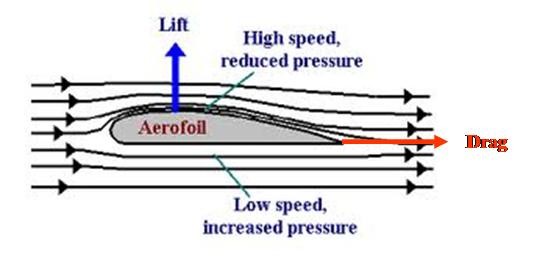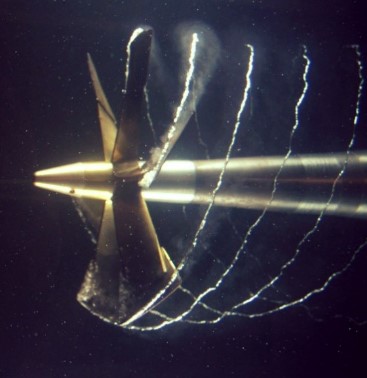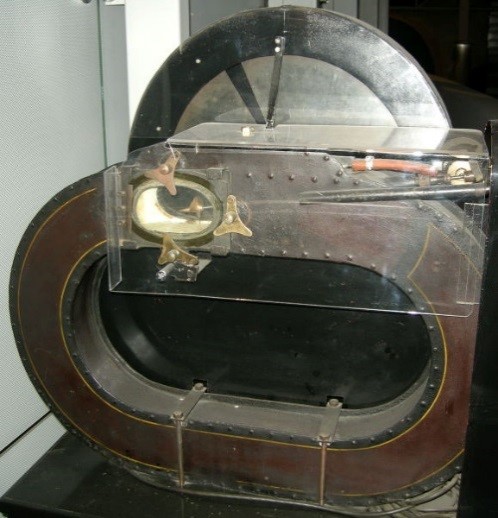Fundamentals
A pdf version of this article can be downloaded here
What is cavitation?
At what temperature does water boil?

Be careful – it’s a trick question.
Water only boils at 100oC when at sea level. On top of Everest it boils at 71oC (making an awful cup of tea). The reason - the air pressure is lower, meaning less energy is needed for the water to turn into a vapour (the steam coming out of a kettle).
This means, if we lower the surrounding pressure sufficiently, water can ‘boil’ without any change in temperature. When this happens underwater we call the phenomenon ‘cavitation’. To be more precise, cavitation is the formation and subsequent implosion of bubbles in a liquid due to rapid changes of pressure.

This is especially important in the design and operation of ships – especially when we look at the propellers, which act in a similar way to aircraft wings. Fluid passes over a specially shaped surface (a foil) creating high pressure on one side and low pressure on the other. This produces the lift from a wing to push a plane up into the sky, and the thrust from a propeller to push a ship through the water.

But the complex pressure changes over a propeller blade can become so severe that the water cavitates (it effectively boils). This can cause huge problems for a ship including reduced power, unwanted noise and even rapid erosion of the propeller blades – they essentially get eaten away by the imploding cavitation bubbles.
Cavitation: A North East innovation
The study of cavitation originated in the North East of England and continues to be a major international research subject with significant contributions from Newcastle University.

Sir Charles Parsons constructed the world’s first cavitation tunnel to test and improve the propeller performance on his prototype ship, the Turbinia, which was equipped with a revolutionary steam turbine engine. Parsons improved the speed of his ship and discovered the existence of propeller cavitation. Both the Turbinia and the original cavitation tunnel are now displayed in Newcastle-upon-Tyne’s Discovery Museum.

A replica of Parson’s tunnel was built in 2006 by James Read, a Newcastle University student, for his final year dissertation (James now works for SMD, one of the North-East’s leading offshore engineering firms who are based on the old Parson’s turbine works site!). The replica can be used to demonstrate the cavitation phenomena originally discovered by Parsons.
The Emerson Cavitation Tunnel at Newcastle University
Since Parsons original, there have been many cavitation tunnels built around the world – some of which are gigantic in comparison. Newcastle University opened its own facility, the Emerson Cavitation Tunnel, in the early 1950s. The tunnel is “medium scale”, measuring 11m long and over 8 metres high (effectively 3 floors of a normal building!). It has been continuously updated over the years with high-tech devices including laser scanners and 3D visualisation equipment. The tunnel is now housed in a purpose-built facility on the coast at Blyth, a few miles north of Newcastle city centre. This facility remains an important research hub for the School of Engineering.

How does a cavitation tunnel work?
A cavitation tunnel pumps water round a loop (called a flume) and past a model scale propeller. The tunnel replicates what happens at sea, with various clever devices to manipulate the way the water flows and the pressure conditions on the propeller blades.

The water flow is crucially important for accurate experiments. The atmospheric pressure can be artificially reduced using a vacuum pump. The water is pushed through a contraction section to speed the flow as it reaches the propeller and then a diffusion section to slow it back down again as it heads back down to the bottom of the flume. The Emerson Cavitation Tunnel can run at speeds up to 10m/s. The propeller is rotated (often at very high speeds) either in undisturbed (open) water or with devices to simulate the complex water flow around the real ship. The behaviour of the cavitation is observed and measured using high speed cameras, strobe lighting, laser scanning, load cells and acoustic sensors.
